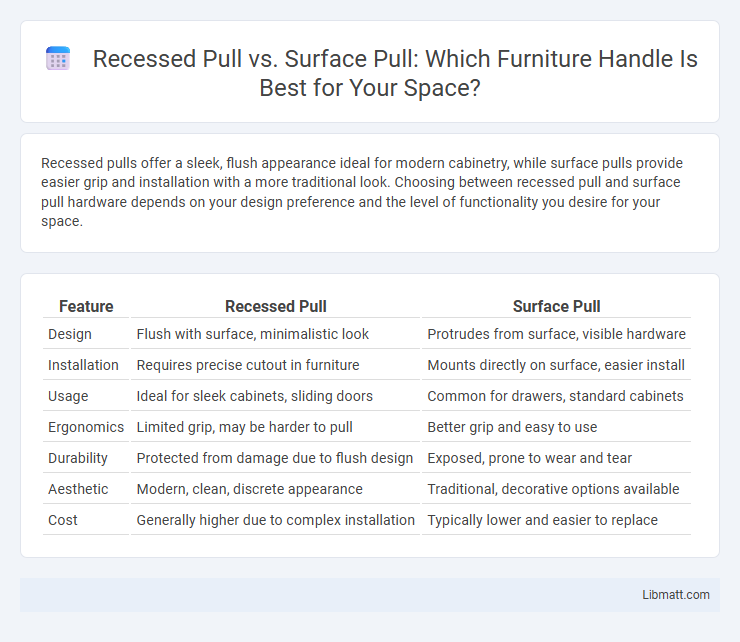Recessed pulls offer a sleek, flush appearance ideal for modern cabinetry, while surface pulls provide easier grip and installation with a more traditional look. Choosing between recessed pull and surface pull hardware depends on your design preference and the level of functionality you desire for your space.
Table of Comparison
| Feature | Recessed Pull | Surface Pull |
|---|---|---|
| Design | Flush with surface, minimalistic look | Protrudes from surface, visible hardware |
| Installation | Requires precise cutout in furniture | Mounts directly on surface, easier install |
| Usage | Ideal for sleek cabinets, sliding doors | Common for drawers, standard cabinets |
| Ergonomics | Limited grip, may be harder to pull | Better grip and easy to use |
| Durability | Protected from damage due to flush design | Exposed, prone to wear and tear |
| Aesthetic | Modern, clean, discrete appearance | Traditional, decorative options available |
| Cost | Generally higher due to complex installation | Typically lower and easier to replace |
Introduction to Recessed Pulls and Surface Pulls
Recessed pulls offer a sleek, flush design embedded into cabinet doors or drawers, providing a minimalist look that reduces snagging and enhances modern aesthetics. Surface pulls, mounted on the exterior, come in various styles and finishes, allowing for greater design flexibility and ease of installation on different furniture types. Both types improve functionality while catering to distinct stylistic preferences in kitchen and furniture hardware.
Key Differences Between Recessed and Surface Pulls
Recessed pulls are embedded into the door or drawer surface, offering a sleek, flush appearance ideal for modern cabinetry and minimizing protrusion. Surface pulls attach directly onto the front of drawers or doors, providing easier grip and a more traditional or decorative look. The choice between recessed and surface pulls impacts design aesthetics, functionality, and ease of use depending on the style and space requirements.
Design and Aesthetic Comparison
Recessed pulls offer a sleek, minimalist design that integrates seamlessly into doors or drawers, creating a flush surface ideal for modern and contemporary interiors. Surface pulls are more pronounced, allowing for a variety of styles, finishes, and shapes that can serve as decorative focal points or enhance traditional and transitional aesthetics. Choosing between recessed and surface pulls depends on whether you prioritize a subtle silhouette or a bold visual statement to complement Your space's overall design theme.
Functional Advantages of Recessed Pulls
Recessed pulls offer superior functionality by providing a flush surface that prevents snagging on clothing or objects, making them ideal for high-traffic areas and tight spaces. Their design allows for smoother operation in minimalist and modern cabinetry, enhancing both aesthetic and ergonomic efficiency. Unlike surface pulls, recessed pulls reduce protrusion, facilitating safer and more streamlined furniture use in compact environments.
Functional Advantages of Surface Pulls
Surface pulls provide easy installation since they attach directly onto cabinet or drawer fronts, eliminating the need for precise cutouts required by recessed pulls. Their protruding design offers better grip and accessibility, enhancing user comfort and efficiency, especially for individuals with limited hand strength or dexterity. Surface pulls also accommodate a wider variety of styles and finishes, enabling greater customization in kitchen and furniture design.
Installation Process: Recessed vs Surface Pull
Recessed pulls require precise cutouts in the door or drawer, demanding accurate measurements and professional tools for a flush installation, which enhances a sleek, minimalistic look. Surface pulls are easier to install, as they simply screw onto the exterior, making them ideal for DIY projects and quick upgrades. Your choice depends on whether you prioritize a seamless design or straightforward installation.
Durability and Maintenance Considerations
Recessed pulls offer enhanced durability due to their flush installation, reducing exposure to physical impacts and minimizing wear over time. Surface pulls, while easier to replace and maintain, are more prone to scratches and damage from frequent use or accidental bumps. Selecting recessed pulls can lower long-term maintenance costs by protecting hardware components and maintaining a clean, functional appearance.
Cost Comparison: Recessed Pulls vs Surface Pulls
Recessed pulls generally have a higher upfront cost due to the precision required for installation and the need for specialized tools or skilled labor. Surface pulls tend to be more cost-effective, offering straightforward installation with minimal tools, which reduces both material and labor expenses. Long-term maintenance costs are typically similar, but recessed pulls may incur additional expenses if adjustments or repairs are needed because of their integrated design.
Best Applications for Each Pull Type
Recessed pulls are ideal for minimalist furniture designs and sliding doors where flush surfaces are essential to prevent snagging and maintain a sleek appearance. Surface pulls work best on cabinet doors and drawers needing easy grip and quick access, especially in kitchens or frequently used storage areas. Choosing the right pull type enhances your space's functionality and aesthetic by aligning with the specific usage and design requirements.
Choosing the Right Pull for Your Project
Selecting the right pull for your project depends on both function and design preferences. Recessed pulls offer a sleek, flush appearance ideal for modern, minimalist spaces, maximizing clean lines and preventing snagging, while surface pulls provide easier grip and a traditional look, suitable for heavier doors or drawers. Consider your project's aesthetic goals and user convenience to ensure your pull choice enhances both style and usability.
Recessed Pull vs Surface Pull Infographic

 libmatt.com
libmatt.com